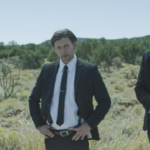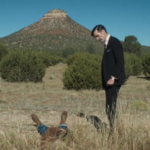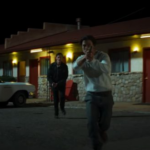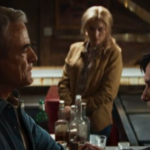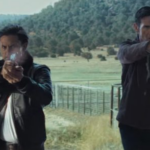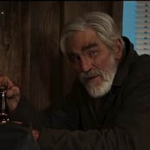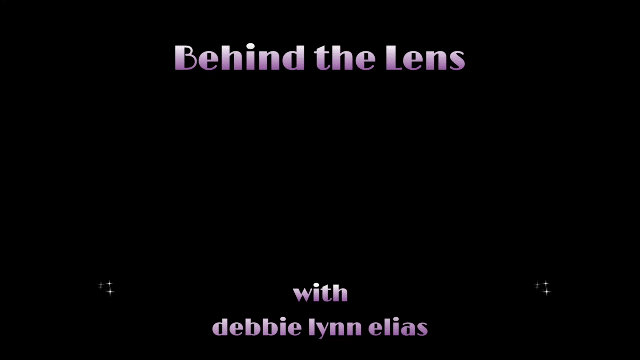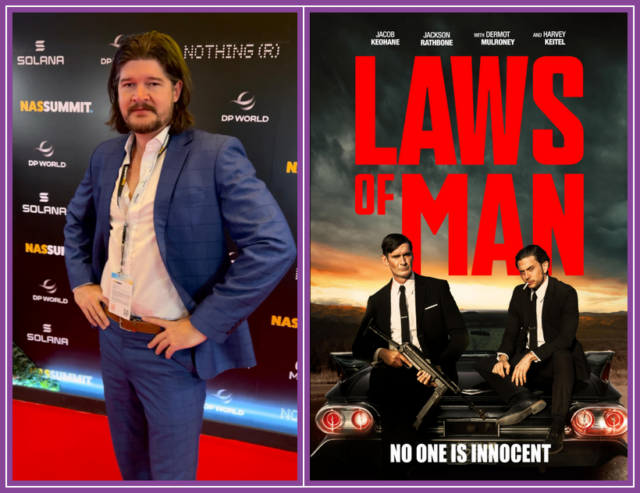
Enthusiasm, excitement, and energy abound in this exclusive interview with writer/director PHIL BLATTENBERGER talking about his latest film, LAWS OF MAN.
SYNOPSIS: Set in 1963 at the dawn of the Cold War, U.S. marshals Frank and Tommy pursue wanted murderer Benjamin Bonney in the deserts of Nevada and stumble upon a sinister plot that threatens to upend the very foundations of justice and peace.
Written and Directed by PHIL BLATTENBERGER, LAWS OF MAN boasts an all-star cast that includes, among others, Jackson Rathbone, Jacob Keohane, Dermot Mulroney, Keith Carradine, Harvey Keitel, Forrie J. Smith, Graham Greene, and Richard Brake.
It didn’t take long for PHIL BLATTENBERGER to quickly become a favorite filmmaker of mine thanks to his outstanding WWII-era film Condor’s Nest, along with his Vietnam-era Point Man. But just to show he’s no one trick or two trick pony or a flash in the pan, now Phil gives us this Cold War era Neo-Western LAWS OF MAN. Talk about blending historical facts with fiction to create an almost “OMG”, “what if” hypothetical scenario! LAWS OF MAN is riveting from start to finish thanks to a creative and solidly written script with a jaw-dropping third-act twist, fully fleshed-out characters, dynamic performances (Dermot Mulroney is mind-blowing while Harvey Keitel is award-worthy), and superb production values in terms of Daniel Troyer’s cinematography, Nico Alba’s editing, and dynamite scoring courtesy of Ching-Shan Chang.
As we dug into all things LAWS OF MAN, Phil highlighted its unique blend of Neo-Western visuals with Cold War intrigue, the star-studded cast, and the exploration of themes of PTSD and trauma as elements woven into several characters. He also emphasizes the challenges of creating a period piece on a low budget, noting the meticulous attention to detail in production design and color grading while praising the editing and the score, both of which enhance the film’s cinematic quality. Some of the production areas we cover in this interview are:
- INSPIRATION FOR THE FILM
- According to Phil, the inspiration for LAWS OF MAN came from his longstanding admiration for Neo-Western films. Drawn to the visual tradition of classic Westerns, but with a modern setting and sensibility, Phil wanted to explore this visual medium and blend it with elements that would appeal to a broader audience. Incorporating character studies of PTSD, trauma, and lost memories allowed him to delve into deeper themes and layers within the story. Phil’s own interest in Cold War politics and history played a significant role in shaping the narrative as he saw this film as an opportunity to “dabble in some stuff” and indulge in his fascination with the complexities of that era, while still maintaining a sense of imagination and fun. Inspired to take a “hard left” turn in the third act, introducing a political intrigue element that blended the Neo-Western aesthetic with a more unexpected and thought-provoking twist allowed him to explore the idea of plausible deniability and the potential for historical events to be hidden from the public. Phil’s diverse influences coalesced to create the unique and multi-faceted world we experience with LAWS OF MAN.
- CHARACTER DEVELOPMENT PROCESS AND COLLABORATION WITH THE CAST
- Emphasizing the importance of building well-developed, three-dimensional characters that the actors could really sink their teeth into, Phil worked closely with the cast, particularly veterans like Harvey Keitel, Keith Carradine, and Graham Greene, to ensure the characters had depth and layers. Sharing anecdotes about the actors’ dedication and preparation, one example is Keitel’s constant communication during pre-production to fully immerse himself in the role. Carradine also impressed Phil with his ability to bring the character to life exactly as Phil had envisioned, with no need for major adjustments. The chemistry and rapport between actors like Jackson Rathbone and Jacob Keohane, both of whom Phil worked with in Condor’s Nest, was also crucial as Phil wanted to capture the nuances of their relationship and explore deeper themes and character motivations beyond the plot points. Every cast member found those small, human moments that added richness and authenticity to the characters.
- CINEMATOGRAPHY AND VISUAL STYLE
- Reteaming with cinematographer Daniel Troyer, the pair deliberately crafted a visual grammar that complemented the multi-layered narrative. The use of desolate, timeless locations created a sense of isolation and a heightened reality, mirroring the characters’ psychological states and the film’s exploration of truth versus perception. The strategic use of color grading was particularly effective. Scenes involving altered states, like Frank’s (Keohane) LSD trip, featured heightened saturation and desaturation to evoke a surreal, almost hallucinatory quality. This visual technique underscored the film’s themes of questioning the nature of reality and the characters’ tenuous grasp of the truth. Utilizing locked-off wide shots and 1970s anamorphic lenses further contributed to the film’s cinematic style. This classic visual approach, combined with modern cinematic techniques, helped to establish the Neo-Western aesthetic that blended the past and present, mirroring the narrative’s exploration of history and conspiracy. Meticulous attention to the visual elements, from the color palette to the camera movements, seamlessly integrated with the film’s thematic concerns, creating a cohesive and immersive cinematic experience.
- EDITING
- The editing process for LAWS OF MAN was “quite challenging” according to Phil. Crediting editor Nico Alba for doing an exceptional job in navigating the complexities of the film, Phil explains that there was a lot of footage shot, with many different elements and layers to the story. Nico had to work with limited options at times due to production challenges, such as issues with lighting and weather. In spite of this, Nico was able to find creative solutions and deliver a cohesive edit that maintained the film’s emotional and visual impact. One of Nico’s great talents is his skill in finding subtle moments and expressions that added depth to the characters, even when the original plan was to exclude them. The collaborative process between Phil and Nico allowed them to refine the pacing and structure, ensuring the multiple storylines and character arcs were balanced effectively.
- SCORE
- Drawing inspiration from Scorsese’s Killers of the Flower Moon, composer Ching-Shan Chang wanted to score something that had classical composition and arrangements, but with a modern bent on it and still keep it grounded. Developing certain musical motifs, notably whenever Frank (Keohane) and Tommy (Rathbone) and working on something investigation-wise or in action, Ching Shan was able to weave those motifs throughout the film. She also excelled at matching moods and playing up to action or drama musically, providing richness to the score.
- BALANCING CREATIVE VISION AND COMMERCIAL VIABILITY
- As an indie filmmaker, Phil acknowledges that he can’t completely indulge himself and has to find ways to appeal to broader consumer bases to ensure the film can be financially viable. Wanting to blend his love of Neo-Westerns with elements that would resonate with audiences, he had to carefully consider how to incorporate the political intrigue and conspiracy themes in a way that would be engaging without alienating viewers. The goal was to create something imaginative and fun, but within a framework that maintained plausible deniability. Phil had to balance his own creative impulses with the practical realities of making an indie film that could find an audience and allow him to move forward to his next project. It was a delicate balance, but one that Phil navigated skillfully.
- AND MORE!
TAKE A LISTEN. . .
by debbie elias, exclusive interview 01/14/2025
LAWS OF MAN is available on VOD and Digital



